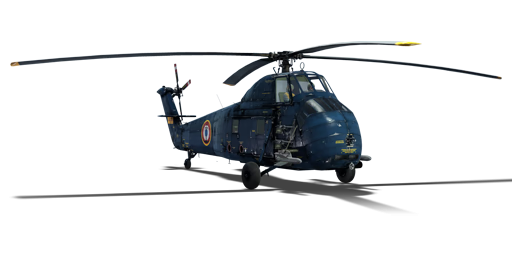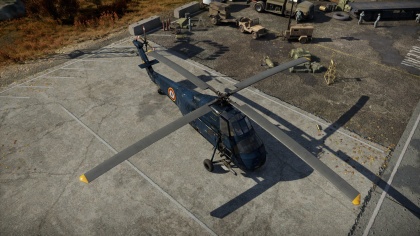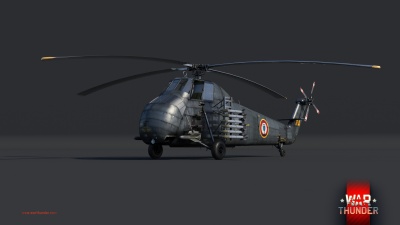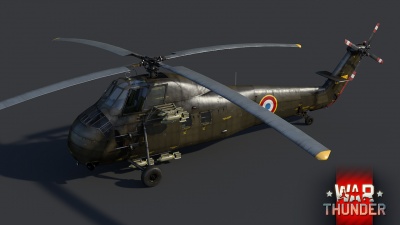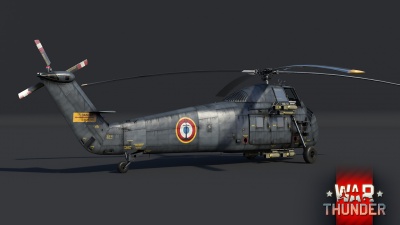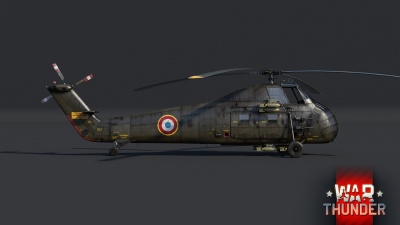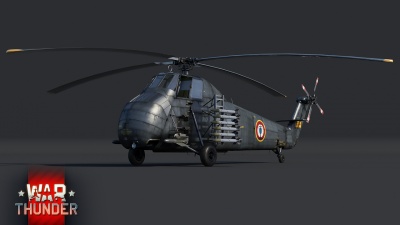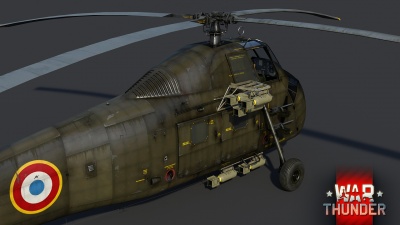Difference between revisions of "H-34 (France)"
Colok76286 (talk | contribs) (→Media: Added Shooting Range episode) |
(Edits) |
||
| Line 5: | Line 5: | ||
| link = H-34 | | link = H-34 | ||
}} | }} | ||
| + | |||
== Description == | == Description == | ||
| − | <!--''In the description, the first part | + | <!-- ''In the description, the first part should be about the history of and the creation and combat usage of the helicopter, as well as its key features. In the second part, tell the reader about the helicopter in the game. Insert a screenshot of the vehicle, so that if the novice player does not remember the vehicle by name, he will immediately understand what kind of vehicle the article is talking about.'' --> |
[[File:GarageImage_{{PAGENAME}}.jpg|420px|thumb|left]] | [[File:GarageImage_{{PAGENAME}}.jpg|420px|thumb|left]] | ||
| − | {{ | + | {{Break}} |
| − | The '''{{ | + | The '''{{Specs|name}}''' is a rank {{Specs|rank}} French attack helicopter {{Battle-rating}}. It was introduced in [[Update 1.87 "Locked On"]]. |
The Sikorsky H-34 was manufactured as a piston-engined military helicopter originally intended for anti-submarine warfare, however, it also has seen service as a medium transport helicopter and as a combat helicopter. This tail dragging helicopter has the radial reciprocating engine mounted in the nose of the aircraft with the driveshaft traversing through the cockpit. | The Sikorsky H-34 was manufactured as a piston-engined military helicopter originally intended for anti-submarine warfare, however, it also has seen service as a medium transport helicopter and as a combat helicopter. This tail dragging helicopter has the radial reciprocating engine mounted in the nose of the aircraft with the driveshaft traversing through the cockpit. | ||
| + | |||
Initial flight of this helicopter took place in March 1954 and the first to enter service with the U.S. Navy took place only six months later. The U.S. Army and Marine Corps also placed orders for this helicopter in 1955 and 1957. Other designations of this helicopter include SH-34, UH-34 and CH-34. For transport purposes, this helicopter can be configured to carry between 12 to 16 troops or if utilized in the role of MedEvac, up to eight stretchers. | Initial flight of this helicopter took place in March 1954 and the first to enter service with the U.S. Navy took place only six months later. The U.S. Army and Marine Corps also placed orders for this helicopter in 1955 and 1957. Other designations of this helicopter include SH-34, UH-34 and CH-34. For transport purposes, this helicopter can be configured to carry between 12 to 16 troops or if utilized in the role of MedEvac, up to eight stretchers. | ||
| − | French aviation company Sud-Aviation assembled a total of 135 H- | + | French aviation company Sud-Aviation assembled a total of 135 H-34's built in the U.S. along with a total of 166 H-34s produced by Sud-Aviation under license from Sikorsky for use in the French Air Force, Navy and Army Aviation (ALAT). |
| − | Due to the ruggedness of the H-34, it had an impressive track record under French command in the Algerian War where it garnered over 190,000 flying hours evacuating French troops from combat locations, including many nighttime operations. | + | Due to the ruggedness of the H-34, it had an impressive track record under French command in the Algerian War where it garnered over 190,000 flying hours evacuating French troops from combat locations, including many nighttime operations. |
Production of the H-34 terminated in 1968 by Sikorsky after building a total of 1,821 of these helicopters. | Production of the H-34 terminated in 1968 by Sikorsky after building a total of 1,821 of these helicopters. | ||
== General info == | == General info == | ||
| − | === Flight | + | === Flight performance === |
| − | ''Describe how the helicopter behaves in the air. | + | ''Describe how the helicopter behaves in the air. Speed, manoeuvrability, acceleration and allowable loads - these are the most important characteristics of the vehicle.'' |
| + | |||
| + | {| class="wikitable" style="text-align:center" | ||
| + | |- | ||
| + | ! rowspan="2" | Characteristics | ||
| + | ! colspan="2" | Max Speed<br>(km/h at 500 m) | ||
| + | ! rowspan="2" | Max altitude<br>(metres) | ||
| + | |- | ||
| + | ! AB !! RB | ||
| + | |- | ||
| + | ! Stock | ||
| + | | 183 || 170 || rowspan="2" | 6,000 <!-- {{Specs|ceiling}} --> | ||
| + | |- | ||
| + | ! Upgraded | ||
| + | | ___ || ___ | ||
| + | |- | ||
| + | |} | ||
=== Survivability and armour === | === Survivability and armour === | ||
| − | ''Examine the survivability of the helicopter. Note how vulnerable the structure is and how secure the pilot is, | + | ''Examine the survivability of the helicopter. Note how vulnerable the structure is and how secure the pilot is, whether the fuel tanks are armoured, etc. Describe the armour, if there is any, and also mention the vulnerability of other critical systems.'' |
== Armaments == | == Armaments == | ||
| Line 37: | Line 55: | ||
=== Suspended armament === | === Suspended armament === | ||
| − | <!--''Describe the helicopter's suspended armament: additional cannons under the winglets, any bombs, and rockets. Since any helicopter is essentially only a platform for suspended weaponry, this section is significant and deserves your special attention. If there is no suspended weaponry remove this subsection.''--> | + | <!-- ''Describe the helicopter's suspended armament: additional cannons under the winglets, any bombs, and rockets. Since any helicopter is essentially only a platform for suspended weaponry, this section is significant and deserves your special attention. If there is no suspended weaponry remove this subsection.'' --> |
| + | {{main|Type 61C (50 kg)|AS.11|HVAR}} | ||
;Option 1: | ;Option 1: | ||
| − | + | * 2 x AS.11 missiles | |
| − | |||
| − | * 2 x | ||
* 6 x HVAR unguided rockets | * 6 x HVAR unguided rockets | ||
| − | In this configuration, the H-34 is equipped with two | + | In this configuration, the H-34 is equipped with two AS.11 ATGM pylons mounted alongside the nose of the aircraft, along with six HVAR unguided rockets mounted on a vertical rail on the left side of the helicopter. |
The helicopter's six HVAR rockets with their 36 mm of high-explosive armour penetration are effective at crippling and possibly destroying enemy tanks with well-placed shots to the roof, engine deck, and tracks. However, their awkward placement on a vertical rail on the left side of the helicopter, as well as their relatively slower velocity and increased drop compared to most other unguided rockets, makes precisely aiming these rockets tricky. | The helicopter's six HVAR rockets with their 36 mm of high-explosive armour penetration are effective at crippling and possibly destroying enemy tanks with well-placed shots to the roof, engine deck, and tracks. However, their awkward placement on a vertical rail on the left side of the helicopter, as well as their relatively slower velocity and increased drop compared to most other unguided rockets, makes precisely aiming these rockets tricky. | ||
| − | A far more effective weapon versus armoured targets, the helicopter's two | + | A far more effective weapon versus armoured targets, the helicopter's two AS.11 ATGM's with their 600 mm of armour penetration can easily damage and destroy enemy tanks and other armoured targets with a well-placed hit. However, this helicopter can only carry two of these missiles at a time, the smallest ATGM loadout of any helicopter in the game, which severely limits the helicopter's combat potential. |
;Option 2: | ;Option 2: | ||
| − | |||
* 10 x 50 kg Type 61C Bombs | * 10 x 50 kg Type 61C Bombs | ||
| Line 59: | Line 75: | ||
In this configuration, the H-34 is equipped with ten 50 kg Type-61C bombs, with six bombs loaded onto external pylons on the sides of the helicopter, and four bombs mounted on rails below the fuselage. These bombs can destroy enemy armoured vehicles when dropped within 2 meters of the target. Their small explosive mass requires particularly careful aim in order to effectively strike at ground targets. However, care must still be taken in order to remain out of the 67 m fragmentation radius of these bombs in order to avoid splash damage to the helicopter itself. | In this configuration, the H-34 is equipped with ten 50 kg Type-61C bombs, with six bombs loaded onto external pylons on the sides of the helicopter, and four bombs mounted on rails below the fuselage. These bombs can destroy enemy armoured vehicles when dropped within 2 meters of the target. Their small explosive mass requires particularly careful aim in order to effectively strike at ground targets. However, care must still be taken in order to remain out of the 67 m fragmentation radius of these bombs in order to avoid splash damage to the helicopter itself. | ||
| − | ==Usage in battles== | + | == Usage in battles == |
| − | ''Describe the tactics of playing in | + | ''Describe the tactics of playing in a helicopter, the features of using the helicopter in a team and advice on tactics. Refrain from creating a "guide" - do not impose a single point of view, but instead, give the reader food for thought. Examine the most dangerous enemies and give recommendations on fighting them. If necessary, note the specifics of the game in different modes (AB, RB, SB).'' |
| − | ===Modules=== | + | === Modules === |
{| class="wikitable" | {| class="wikitable" | ||
! Tier | ! Tier | ||
| − | ! colspan="2" |Flight performance | + | ! colspan="2" | Flight performance |
! Survivability | ! Survivability | ||
| − | ! colspan="2" |Weaponry | + | ! colspan="2" | Weaponry |
|- | |- | ||
| I | | I | ||
| − | | Compressor | + | | Compressor |
| + | | | ||
| Flak jacket | | Flak jacket | ||
| − | | Offensive 7 mm | + | | Offensive 7 mm |
| + | | | ||
|- | |- | ||
| II | | II | ||
| − | | | + | | |
| + | | | ||
| Helicopter frame | | Helicopter frame | ||
| − | | | + | | |
| + | | Type 61C | ||
|- | |- | ||
| III | | III | ||
| − | | Engine | + | | Engine |
| − | | | + | | Replacing helicopter blades |
| − | | New 7 mm MGs | + | | NVD |
| + | | New 7 mm MGs | ||
| + | | | ||
|- | |- | ||
| IV | | IV | ||
| − | | | + | | |
| + | | | ||
| Cover | | Cover | ||
| − | | | + | | |
| + | | | ||
|- | |- | ||
|} | |} | ||
| − | ===Pros and cons=== | + | === Pros and cons === |
| − | <!-- | + | <!-- ''Summarise and briefly evaluate the vehicle in terms of its characteristics and combat effectiveness. Mark its pros and cons in the bulleted list. Try not to use more than 6 points for each of the characteristics. Avoid using categorical definitions such as "bad", "good" and the like - use substitutions with softer forms such as "inadequate" and "effective".'' --> |
'''Pros:''' | '''Pros:''' | ||
| Line 108: | Line 132: | ||
== History == | == History == | ||
| − | <!--''Describe the history of the creation and combat usage of the helicopter in more detail than in the introduction. If the historical reference turns out to be too | + | <!-- ''Describe the history of the creation and combat usage of the helicopter in more detail than in the introduction. If the historical reference turns out to be too long, take it to a separate article, taking a link to the article about the vehicle and adding a block "/History" (example: <nowiki>https://wiki.warthunder.com/(Vehicle-name)/History</nowiki>) and add a link to it here using the <code>main</code> template. Be sure to reference text and sources by using <code><nowiki><ref></ref></nowiki></code>, as well as adding them at the end of the article with <code><nowiki><references /></nowiki></code>. This section may also include the vehicle's dev blog entry (if applicable) and the in-game encyclopedia description (under <code><nowiki>=== In-game description ===</nowiki></code>, also if applicable).'' --> |
The H-34 was developed in the early 1950s as the successor to the H-19 Chickasaw. The new helicopter was enlarged and was overall more powerful than its predecessor, yet still retained some of the core design elements, such as the nose-mounted radial engine under the cockpit. | The H-34 was developed in the early 1950s as the successor to the H-19 Chickasaw. The new helicopter was enlarged and was overall more powerful than its predecessor, yet still retained some of the core design elements, such as the nose-mounted radial engine under the cockpit. | ||
| Line 115: | Line 139: | ||
However, the H-34 was also widely exported and built under licence by other nations. France was one of the earliest nations to adopt the H-34, with it entering service in 1956. France initially received a large number of American-built disassembled H-34s, which were then reassembled in France. Later on, the Sud-Aviation company acquired a licence to produce the H-34s locally. In the end, close to 300 French H-34s were built and used by the French forces. The vehicle was actively used during the war in Algeria, marking the first mass use of attack helicopters by the French army. | However, the H-34 was also widely exported and built under licence by other nations. France was one of the earliest nations to adopt the H-34, with it entering service in 1956. France initially received a large number of American-built disassembled H-34s, which were then reassembled in France. Later on, the Sud-Aviation company acquired a licence to produce the H-34s locally. In the end, close to 300 French H-34s were built and used by the French forces. The vehicle was actively used during the war in Algeria, marking the first mass use of attack helicopters by the French army. | ||
| − | Of course, the H-34 Choctaw saw service with many more countries around the world and participated in numerous conflicts of the | + | Of course, the H-34 Choctaw saw service with many more countries around the world and participated in numerous conflicts of the '50s and '60s. Although the helicopter was being phased out from military service with most operators by the 1970s, the H-34 (or S-58 if the civilian designation is used) is still being used for civilian operations today. In total, over 2,100 H-34s were built when taking into account all modifications of the type. |
| − | ''- From [ | + | ''- From [[wt:en/news/6083-development-h-34-choctaw-a-worthy-start-en|Devblog]]'' |
== Media == | == Media == | ||
<!-- ''Excellent additions to the article would be video guides, screenshots from the game, and photos.'' --> | <!-- ''Excellent additions to the article would be video guides, screenshots from the game, and photos.'' --> | ||
;Images | ;Images | ||
| − | < | + | <gallery mode="packed" heights="150px"> |
| − | + | File:H-34 France WTWallpaper 001.jpg | |
| − | + | File:H-34 France WTWallpaper 002.jpg | |
| − | + | File:H-34 France WTWallpaper 003.jpg | |
| − | + | File:H-34 France WTWallpaper 004.jpg | |
| − | + | File:H-34 France WTWallpaper 005.jpg | |
| − | + | File:H-34 France WTWallpaper 006.jpg | |
| − | </ | + | </gallery> |
;Videos | ;Videos | ||
| Line 135: | Line 159: | ||
== See also == | == See also == | ||
| − | <!--''Links to the articles on the War Thunder Wiki that you think will be useful for the reader, for example:'' | + | <!-- ''Links to the articles on the War Thunder Wiki that you think will be useful for the reader, for example:'' |
* ''reference to the series of the helicopter;'' | * ''reference to the series of the helicopter;'' | ||
| − | * ''links to approximate analogues of other nations and research trees.''--> | + | * ''links to approximate analogues of other nations and research trees.'' --> |
;Related aircraft | ;Related aircraft | ||
* Sikorsky [[H-34]] (USA) | * Sikorsky [[H-34]] (USA) | ||
| Line 145: | Line 169: | ||
== External links == | == External links == | ||
| − | <!--''Paste links to sources and external resources, such as:'' | + | <!-- ''Paste links to sources and external resources, such as:'' |
* ''topic on the official game forum;'' | * ''topic on the official game forum;'' | ||
| − | * ''encyclopedia page on helicopter;'' | + | * ''encyclopedia page on the helicopter;'' |
| − | * ''other literature.''--> | + | * ''other literature.'' --> |
| − | * [ | + | * [[wt:en/news/6083-development-h-34-choctaw-a-worthy-start-en|[Devblog] H-34 Choctaw: A Worthy Start]] |
{{AirManufacturer Sikorsky}} | {{AirManufacturer Sikorsky}} | ||
{{France helicopters}} | {{France helicopters}} | ||
Revision as of 18:03, 12 September 2020
Contents
| This page is about the French utility helicopter H-34 (France). For other version, see H-34. |
Description
The ▄H-34 is a rank V French attack helicopter
with a battle rating of 8.3 (AB/SB) and 7.7 (RB). It was introduced in Update 1.87 "Locked On".
The Sikorsky H-34 was manufactured as a piston-engined military helicopter originally intended for anti-submarine warfare, however, it also has seen service as a medium transport helicopter and as a combat helicopter. This tail dragging helicopter has the radial reciprocating engine mounted in the nose of the aircraft with the driveshaft traversing through the cockpit.
Initial flight of this helicopter took place in March 1954 and the first to enter service with the U.S. Navy took place only six months later. The U.S. Army and Marine Corps also placed orders for this helicopter in 1955 and 1957. Other designations of this helicopter include SH-34, UH-34 and CH-34. For transport purposes, this helicopter can be configured to carry between 12 to 16 troops or if utilized in the role of MedEvac, up to eight stretchers.
French aviation company Sud-Aviation assembled a total of 135 H-34's built in the U.S. along with a total of 166 H-34s produced by Sud-Aviation under license from Sikorsky for use in the French Air Force, Navy and Army Aviation (ALAT).
Due to the ruggedness of the H-34, it had an impressive track record under French command in the Algerian War where it garnered over 190,000 flying hours evacuating French troops from combat locations, including many nighttime operations.
Production of the H-34 terminated in 1968 by Sikorsky after building a total of 1,821 of these helicopters.
General info
Flight performance
Describe how the helicopter behaves in the air. Speed, manoeuvrability, acceleration and allowable loads - these are the most important characteristics of the vehicle.
| Characteristics | Max Speed (km/h at 500 m) |
Max altitude (metres) | |
|---|---|---|---|
| AB | RB | ||
| Stock | 183 | 170 | 6,000 |
| Upgraded | ___ | ___ | |
Survivability and armour
Examine the survivability of the helicopter. Note how vulnerable the structure is and how secure the pilot is, whether the fuel tanks are armoured, etc. Describe the armour, if there is any, and also mention the vulnerability of other critical systems.
Armaments
Offensive armament
- 4 x 7.62 mm Browning machine guns (250 rpg = 1,000 total)
The helicopter's machine guns are mounted towards the nose of the helicopter in front of the landing gear struts. These machine guns can be loaded with one of four different ammo belts (Default, Universal, Tracers, and Stealth). However, owing to their small calibre, they are only effective for attacking very lightly armoured targets (< 10 mm maximum armour thickness), they have limited effectiveness against aircraft and are ultimately useless against armoured targets. Their relatively low rate of fire offers better aim controllability at the expense of total damage output.
Suspended armament
- Option 1
- 2 x AS.11 missiles
- 6 x HVAR unguided rockets
In this configuration, the H-34 is equipped with two AS.11 ATGM pylons mounted alongside the nose of the aircraft, along with six HVAR unguided rockets mounted on a vertical rail on the left side of the helicopter.
The helicopter's six HVAR rockets with their 36 mm of high-explosive armour penetration are effective at crippling and possibly destroying enemy tanks with well-placed shots to the roof, engine deck, and tracks. However, their awkward placement on a vertical rail on the left side of the helicopter, as well as their relatively slower velocity and increased drop compared to most other unguided rockets, makes precisely aiming these rockets tricky.
A far more effective weapon versus armoured targets, the helicopter's two AS.11 ATGM's with their 600 mm of armour penetration can easily damage and destroy enemy tanks and other armoured targets with a well-placed hit. However, this helicopter can only carry two of these missiles at a time, the smallest ATGM loadout of any helicopter in the game, which severely limits the helicopter's combat potential.
- Option 2
- 10 x 50 kg Type 61C Bombs
In this configuration, the H-34 is equipped with ten 50 kg Type-61C bombs, with six bombs loaded onto external pylons on the sides of the helicopter, and four bombs mounted on rails below the fuselage. These bombs can destroy enemy armoured vehicles when dropped within 2 meters of the target. Their small explosive mass requires particularly careful aim in order to effectively strike at ground targets. However, care must still be taken in order to remain out of the 67 m fragmentation radius of these bombs in order to avoid splash damage to the helicopter itself.
Usage in battles
Describe the tactics of playing in a helicopter, the features of using the helicopter in a team and advice on tactics. Refrain from creating a "guide" - do not impose a single point of view, but instead, give the reader food for thought. Examine the most dangerous enemies and give recommendations on fighting them. If necessary, note the specifics of the game in different modes (AB, RB, SB).
Modules
| Tier | Flight performance | Survivability | Weaponry | ||
|---|---|---|---|---|---|
| I | Compressor | Flak jacket | Offensive 7 mm | ||
| II | Helicopter frame | Type 61C | |||
| III | Engine | Replacing helicopter blades | NVD | New 7 mm MGs | |
| IV | Cover | ||||
Pros and cons
Pros:
- Surprisingly fast, able to maintain speeds in excess of 322 kph (200 mph) in level flight
- Decent structural durability, though this isn't saying much
Cons:
- Large size makes it a large target
- Sluggish handling characteristics
- Weak engine and rotor transmission durability - a few hits from light-caliber rounds can quickly destroy them
- Awkward HVAR rocket placement makes accurate aim tricky
- Bomb loadout is inadequate against heavily armored targets
History
The H-34 was developed in the early 1950s as the successor to the H-19 Chickasaw. The new helicopter was enlarged and was overall more powerful than its predecessor, yet still retained some of the core design elements, such as the nose-mounted radial engine under the cockpit.
The H-34 performed its maiden flight in March 1954 and was adopted into service shortly afterwards, first with the U.S. Navy in 1955 and then U.S. Army in 1956.
However, the H-34 was also widely exported and built under licence by other nations. France was one of the earliest nations to adopt the H-34, with it entering service in 1956. France initially received a large number of American-built disassembled H-34s, which were then reassembled in France. Later on, the Sud-Aviation company acquired a licence to produce the H-34s locally. In the end, close to 300 French H-34s were built and used by the French forces. The vehicle was actively used during the war in Algeria, marking the first mass use of attack helicopters by the French army.
Of course, the H-34 Choctaw saw service with many more countries around the world and participated in numerous conflicts of the '50s and '60s. Although the helicopter was being phased out from military service with most operators by the 1970s, the H-34 (or S-58 if the civilian designation is used) is still being used for civilian operations today. In total, over 2,100 H-34s were built when taking into account all modifications of the type.
- From Devblog
Media
- Images
- Videos
See also
- Related aircraft
- Sikorsky H-34 (USA)
- Aircraft of comparable role, configuration and era
- Mil Mi-4 Hound
External links
| Sikorsky Aircraft Corporation | |
|---|---|
| Utility | H-34 |
| Attack | MH-60L DAP |
| Export | ▄H-34 · AH-60 |
| France helicopters | |
|---|---|
| Attack | ▄H-34 · EC-665 Tiger HAD · Tiger HAD Block 2 · EC-665 Tiger HAP |
| Utility | IAR 316B · SA 313B Alouette II · SA 316B Alouette III · SA.341F Gazelle · SA.342M Gazelle |


